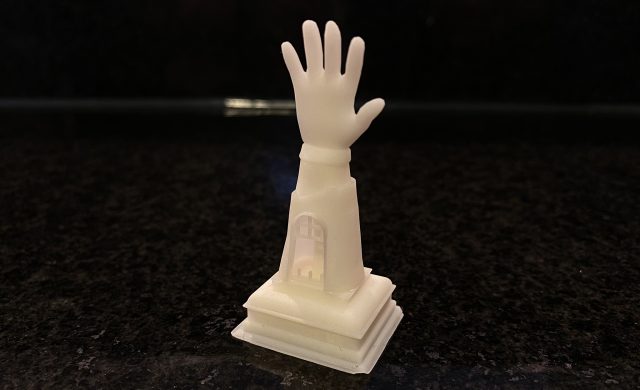Pilgrimage class offers hands-on experience and opportunity to collaborate across disciplines
September 9, 2021 BY

This 3D reliquary model of a hand was printed during a trial run for REL 340: Pilgrimage: Sacred Journeys, a new course being offered at the university this fall. The class is a collaborative effort between the Department of Religion and Philosophy and the Department of Mechanical Engineering. Photo courtesy of Yiwei Han/Department of Mechanical Engineering
A University of Mississippi professor has created a new religion course that combines academic study of religious pilgrimages with the creation of 3D images of ancient relics.
The course, REL 340: Pilgrimage: Sacred Journeys, examines many material objects that serve as pilgrimage destinations – particularly saints’ relics, which can be corporal, such as bones, or contact, such as cloth or oils, said Mary Thurlkill, professor of religion. For example, religious pilgrims visit Mount Sinai in Egypt, the “head of John the Baptist” in Rome and Jesus’ “crown of thorns” in Paris.
Relics are generally displayed in reliquaries, which can be extravagantly adorned cases or simple mounts.
“My students will research different pilgrimage destinations, both their historical foundations and contemporary rituals, and design their own reliquary for an imagined relic,” Thurlkill said. “They will learn about a particular holy place and will think critically about how material culture – i.e., the ‘stuff’ of religion – links with belief – i.e., the ‘theology’; how human beings ‘live’ their religion through various rituals; and why such material objects/symbols are important to us.”
Students taking the course said they are enthusiastic about what they will learn during the semester.
“It’s a really amazing class,” said Johnathon “JC” Smith Jr., a senior from Mooreville who is majoring in philosophy with an emphasis in religious studies. “Pilgrimages are something that is seen in every religion, and in every culture.
“The course is beneficial because it demonstrates, just like religious studies and like all the humanities, there are many paths to truth and understanding.”
A unique assignment in Thurlkill’s course involves a collaboration with Yiwei Han, an assistant professor of mechanical engineering, and his M E 523: Introduction to Additive Manufacturing course. Students from Thurlkill’s class will get experience in 3D printing, while students from Han’s class will gain some knowledge in the humanities.
“I first approached Dr. Han about the joint assignment after reading an article about a museum that produced 3D models of certain artifacts for their audience to handle/touch,” Thurlkill said. “This intrigued me because, by doing so, the museum was allowing another sensory ‘engagement’ with historical artifacts – through touch.
“It also demonstrated how the humanities – in this example, museum studies and fine arts – link with so many different fields.”
Han said he sees the venture as a great idea for students from two totally different fields to work together.
“This is the first time we have applied 3D printing in REL 340 class,” he said. “It is not often for us to see some works that combine 3D printing and religion. This time, students will have a chance to apply their skills to archive something that they have never done before.”
Han’s research interests are micro/nano fabrication, additive manufacturing, advanced manufacturing and printing electronics. His graduate students and other students interested in his research are using his lab, which houses a 3D printer customized for high-resolution 3D and 4D printing.
Han said the experience is very important for engineering students.
“With the real-world application, they can get many hands-on experiences that will help them in the future,” he said. “The students who take this class will perform interdisciplinary research and get some experience of working with others from outside of their fields.”